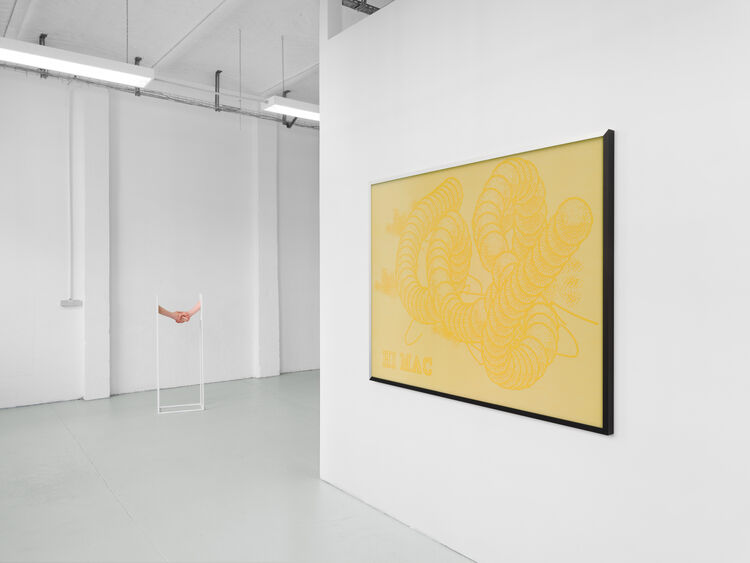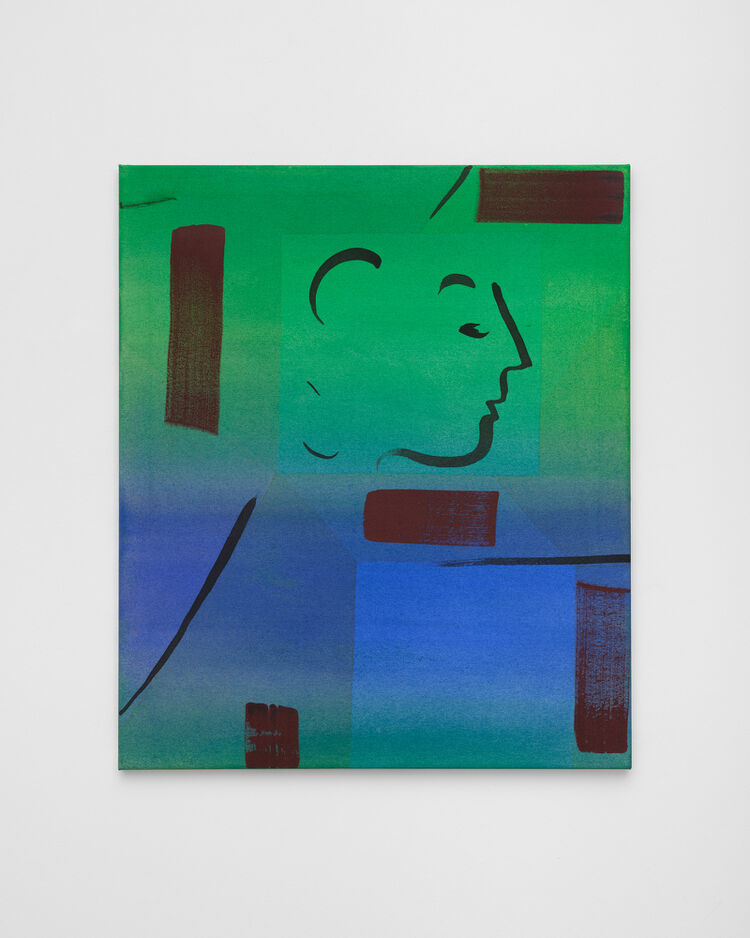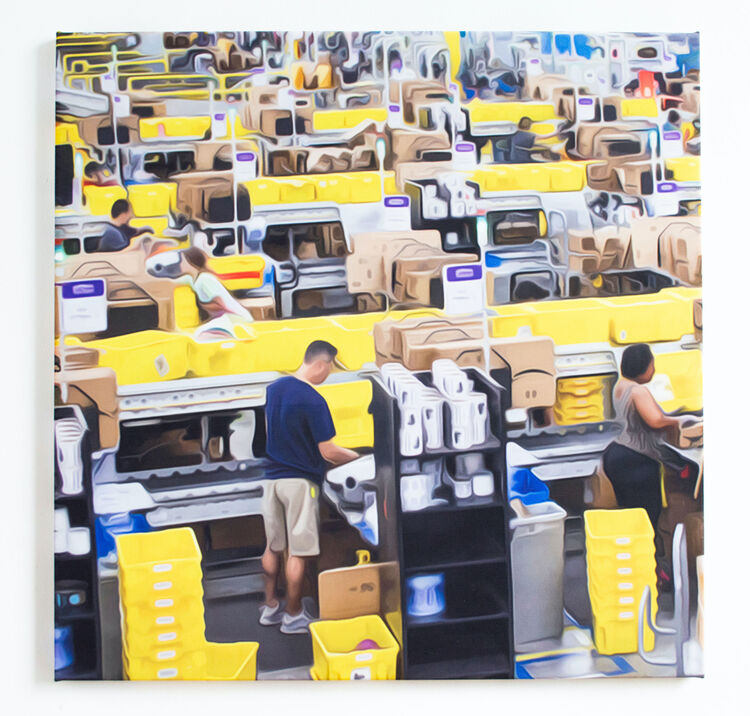Jagoda Bednarsky 'Hokus Pokus Hyper Fokus'
Jagoda Bednarsky
'HOKUS POKUS HYPER FOKUS'
Solo show
16.02. – 05.04. 2024
Opening, 16.04. – 6 – 9 pm
Wed – Fri, 3 – 6 pm
Text by Annika von Taube
Deception is generally understood to be circumstances or sensory perceptions that do not correspond to truth or reality. Seen in this light, most art is nothing but deception. It is not interested in what is „true“ or „real“; each work creates its own reality, and each viewer's eye sees its own truth in it, characterised by everything it has seen before and from which angle it is looking. Visual worlds, role models, self-image, all factors that condition the reading of images, and if you are lucky, they miraculously merge into a new realisation, like a successful alchemical experiment – and that brings us to the art of Jagoda Bednarsky.
Bednarsky's painting is sometimes described as unearthly, dreamlike, fantastic, which is not least due to her preference for soft pastel colours and may also apply to the works in this exhibition, but one should not be lulled by this, but rather pay attention to the exhibition title, as the etymological origin of „HOKUS POKUS“ lies in the guild of tricksters and their tricks, who, incidentally, were still classified as „merry arts“ in the Middle Ages and only acquired their reputation as swindlers and petty criminals in the course of modern times. Although Bednarsky's pictures are not guilty of any trickery or attempted fraud, they utilise the same mechanisms of perception manipulation that are common in trickery and magic tricks (and indispensable for their success). In essence, the aim is always to draw attention to a detail that takes on the utmost importance at the moment of observation (which brings us to the „HYPER FOCUS“ in the exhibition title), even though it only serves to distract from the actual event. Does that make it unimportant? On the contrary, it is of fundamental importance for the success of the trick, and proof that the most important and the essential are often not one and the same thing.
As far as Bednarsky's subjects are concerned, the order and weighting of the details observed has an enormous influence on the effect of the picture as a whole. Why is it that I only recognise what it is when I look at it for the third time? And what am I suddenly seeing here that wasn't there before? The outstretched frog's hand, which seems to dominate the picture until you recognise the body that goes with it and thus another layer of the picture; the blurred garland, which turns out to be lettering, or more precisely, the artist’s name, although she always signs the back of her canvases; the blossoms of a wreath of flowers, outlined like colouring book templates, on which the gaze initially lingers until it sinks all the deeper into the shimmering infinity that surrounds it like a gateway to another world.
The curtains, which separate here part of the gallery space in such a way that a room within a room is created, are also part of the game with perception. Those who follow their promising invitation will find themselves in „Shadowland“, the title of an ongoing series of works that revolves around female breasts. Sometimes they pile up to form a hilly landscape, sometimes they float in perfect curves like soap bubbles through delicate air, sweetly alluring and desirable in their beauty and yet too far removed to arouse sexual desire, a playful, loving homage to femininity – this series is inspired by the ruthless reality of motherhood, a literal self-reflection of the artist in her role as a mother. The rather unusual sideways perspective of the breast originates from the mother's point of view looking down at herself while breastfeeding her baby. The frontal view of the breast, which is far more common in the history of painting, is only taken by a woman when she looks at herself naked in a mirror, and thus from an external perspective. Here behind the curtain, however, the gaze begins with an interior perspective and, laden with all the aforementioned influences on the reading of pictures, makes its way back to the outside.
Standing in front of the picture and being in the picture at the same time, recognising oneself and the other at the same moment, seeing inside and outside as one – what seems impossible according to the laws of logic comes naturally to Jagoda Bednarsky. There's just a bit of hocus-pocus involved…
Text von Annika von Taube
Als Täuschung gelten nach allgemeinem Verständnis Umstände oder Sinneswahrnehmungen, die nicht der Wahrheit oder Wirklichkeit entsprechen. So gesehen ist die meiste Kunst nichts als Täuschung. Was „wahr“ ist oder „wirklich“, interessiert sie jedenfalls nicht, jedes Werk schafft seine eigene Wirklichkeit, und jedes Betrachterauge sieht darin seine eigene Wahrheit, geprägt von allem, was es davor bereits gesehen hat und aus welchem Blickwinkel es schaut. Bildwelten, Rollenbilder, Selbstbild, alles Faktoren, die das Lesen von Bildern konditionieren, und wenn man Glück hat, verschmelzen sie auf wundersame Weise zu einer neuen Erkenntnis, wie ein geglücktes alchemistisches Experiment – und damit sind wir bei der Kunst von Jagoda Bednarsky.
Als überirdisch, traumartig, fantastisch wird Bednarskys Malerei bisweilen beschrieben, was nicht zuletzt ihrer Vorliebe für sanfte Pastelltöne geschuldet sein und auch für die Arbeiten in dieser Ausstellung zutreffen mag, aber davon sollte man sich nicht einlullen lassen, sondern lieber auf den Ausstellungstitel achten, liegt der etymologische Ursprung von „HOKUS POKUS“ doch in der Zunft der Taschen- oder Trickspieler, die übrigens im Mittelalter noch den „heiteren Künsten“ zugeordnet wurden und ihren Ruf als Betrüger und Kleinkriminelle erst im Verlauf der Neuzeit erwarben. Nun machen sich die Bilder von Bednarsky zwar keiner Tricksereien oder Betrugsversuche schuldig, aber sie bedienen sich der gleichen Mechanismen von Wahrnehmungsmanipulation, wie sie bei Trickbetrug wie Zaubertricks üblich (und für deren Gelingen unabdingbar) sind. Im Kern geht es immer darum, alle Aufmerksamkeit auf ein Detail zu lenken, das im Moment der Betrachtung allerhöchste Bedeutung erhält (womit wir beim „HYPER FOKUS“ im Ausstellungstitel wären), obwohl es nur der Ablenkung vom eigentlichen Geschehen dient. Ist es deshalb unwichtig? Im Gegenteil, für das Gelingen des Tricks ist es von fundamentaler Bedeutung, und ein Beweis dafür, dass das Wichtigste und das Wesentliche oft nicht ein und dasselbe sind.
Was Bednarskys Sujets betrifft, hat die Reihenfolge und Gewichtung der betrachteten Details enormen Einfluss auf die Wirkung des gesamten Bildes. Warum erkenne ich erst beim dritten Hinschauen, was das da ist? Und was sehe ich denn hier auf einmal, das war doch eben noch nicht da? Die hochgestreckte Froschhand, die das Bild zu dominieren scheint, bis man auch den dazugehörigen Körper ausmacht und damit eine weitere Bildebene; die verschwommene Girlande, die sich als Schriftzug erweist, genauer, als Name der Künstlerin, obwohl die doch ansonsten ihre Leinwände immer rückseitig signiert; die wie Malbuchvorlagen konturierten Blüten eines Blumenkranzes, an denen der Blick erst einmal hängenbleibt, bis er umso tiefer versinkt im flirrenden Unendlichkeitsgewaber, das dieser umkränzt wie ein Tor zu einer anderen Welt.
Auch die Vorhänge, die hier einen Teil des Galerieraums so abtrennen, dass ein Raum im Raum entsteht, sind Teil des Spiels mit der Wahrnehmung. Wer ihrer verheißungsvollen Einladung folgt, findet sich im „Shadowland“ wieder, so der Titel einer fortlaufenden Werkserie, die um weibliche Brüste kreist. Mal türmen sich diese auf zu einer hügeligen Landschaft, mal schweben sie in perfekter Rundung wie Seifenblasen durch zarte Lüfte, lieblich lockend und begehrenswert in ihrer Schönheit und doch zu sehr entrückt, um sexuelles Verlangen zu wecken, eine spielerische, liebevolle Huldigung an die Weiblichkeit – dabei ist diese Serie inspiriert von der schonungslosen Realität der Mutterschaft, eine buchstäbliche Selbstreflektion der Künstlerin in ihrer Mutterrolle. Die eher ungewöhnliche seitliche Perspektive auf die Brust nämlich entspringt dem Blickwinkel der Mutter an sich selbst herab, während sie ihren Säugling stillt. Die in der Geschichte der Malerei weitaus üblichere Frontalansicht der Brust nimmt eine Frau nur ein, wenn sie sich nackt im Spiegel betrachtet, und damit aus der Außenperspektive. Hier hinter dem Vorhang aber beginnt der Blick bei der Innenperspektive und bahnt sich, beladen mit allem, was eingangs genannte Einflüsse auf das Lesen von Bildern mit sich bringen, seinen Weg zurück ins Außen.
Gleichzeitig vor dem Bild stehen und im Bilde sein, im selben Moment sich selbst und das Andere erkennen, Innen und Außen als Einheit sehen – was nach den Gesetzen der Logik ein Ding der Unmöglichkeit scheint, ergibt sich bei Jagoda Bednarsky wie selbstverständlich. Es ist halt ein bisschen Hokuspokus im Spiel…






























































